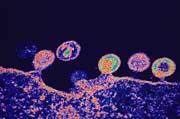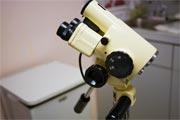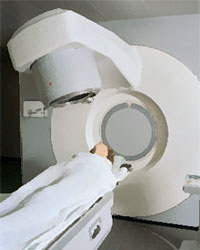A patient-friendly overview of the symptoms, causes and treatment alternatives available for cervical cancer and dysplasia including surgery, drugs, radiotherapy and alternative therapies such as proton beam therapy, immunotherapy and off-label drugs, and targeting HPV.
Cervical cancer, or cancer of the cervix
We aim to give you an holistic health approach and provide everything you need to know to help you increase your personal odds of beating cervical cancer. We will even cover the causes particularly looking at what you might do to restrict an HPV infection.
This article has been compiled by Chris Woollams from worldwide research and expert sources.*
Introduction
 Cervical cancer may also be called cancer of the cervix. The cervix is at the top of the vagina - it is the lower part of, and the entrance to, the womb. It actually regulates what goes in, and what goes out. It actually protects you by keeping things like germs, tampons and swimming pool water out of your womb.
Cervical cancer may also be called cancer of the cervix. The cervix is at the top of the vagina - it is the lower part of, and the entrance to, the womb. It actually regulates what goes in, and what goes out. It actually protects you by keeping things like germs, tampons and swimming pool water out of your womb.
The womb is a muscular organ, the lining of which develops each month and then is shed. This latter action is most commonly called a period.
Womb, or Endometrial cancer, is covered in detail elsewhere on this website.
Cancer of the Cervix; Cervical cancer
A little over 3,000 women are currently diagnosed with cervical cancer each year in the UK. There were 854 recorded deaths in 2016. The peak age group is 25-30 with about 460 cases, and the numbers in each 5 year age group decline almost linearly thereafter. Only 11% of cervical cancers develop in the over 70 age group, so this is certainly not your typical cancer.
Since 1990, the incidence amongst the 35-49 age group has decreased by 20%, and amongst the 50-64s by 38%. You may start to feel that this is a rare cancer.
One issue for cervical cancer is ’prediction’ - it’s all about statistics and what ’experts’ believe is going to happen in the future. Since 1990, CRUK states that the rate in 20-24s has increased 93%; and in 25-34s by 47%; and in 35-49 by 20%. ’Experts’ are predicting a 43% total increase by 2035. This would take the number of deaths to around 1200 in the UK (CRUK).
In America, according to the American Cancer Society, 13,240 new cases will be diagnosed in 2018, with about 4,170 deaths.
Most commonly cervical cancer occurs in one of two forms:
* Squamous cell carcinoma (80 per cent) - develops from the cells on the surface of the cervix;
* Adenocarcinoma (20 per cent) - develops from the glandular cells of the cervix wall.
This is normally a very slow growing cancer and can take years to develop. During that time abnormal cells will develop first. These are not cancer cells but are often called pre-cancerous cells, which is actually slightly inaccurate and misleading as not always do these pre-cancerous cells turn into the full-blown thing. And anyway they can be treated.
The condition where a woman has pre-cancerous cells is called dysplasia - this is not cancer - and the cells are technically termed cervical intra-epithelial neoplasia, or CIN. Because the term pre-cancerous is so misleading, I am going to simply call them rogue cells instead.
So, cervical cancer invariably goes through a stage of first having rogue cells present; but not all such rogue cells ever become cervical cancer. CIN is often dealt with by the use of ablation where a small needle heats or freezes the cells until they die. The treatment is easily performed and virtually painless.
Which is why testing to find out if any rogue cells are present is so important. It is called cervical cancer screening.
Cervical Cancer screening
Because of cervical cancer screening, more women are being ’caught’ at the pre- or early stages, where treatment is most effective.
 Regular screening to find out if rogue cells are present is so important
Regular screening to find out if rogue cells are present is so important
The most common test is the Pap Smear test where the woman lies on her back, legs apart, the vagina is held open using a speculum, and cells are scraped from the cervix using a spatula or a brush. These cells are then sent away to be examined under a microscope in a laboratory elsewhere and you are told the results days later. An annual Pap smear is the US recommendation three years after a girl first starts intercourse. Researchers at Memorial Sloan-Kettering in the USA believe 84 per cent of cervical cancer deaths are already prevented because of such screening methods. However, this test is not infallible; for example, some adenocarcinomas are hard to detect in this way.
 Pap Smear test are not infallible - a test using vinegar is!!
Pap Smear test are not infallible - a test using vinegar is!!
Not all our readers are from the USA, Canada, Australia and the UK. Many are from India, Africa and South East Asia. As we have covered several times in icon, there is a 100 per cent reliable test involving common acetic acid (vinegar) and the use of a light which makes the rogue cells fluoresce. It costs next to nothing and you can be told the results straight away. Countries such as India who do not have vast health resources are rapidly implementing this system. Women taking part in these trials were 25 per cent less likely to contract cervical cancer and 35 per cent less likely to die from it because it is more accurate.
You can also have a screening test to determine whether the DNA of the Human Papillomavirus (HPV) is present in the cervix.
The Causes of cervical cancer
The primary reason women develop cervical cancer is due to a poor immune system. Let me explain.
1. HPV and cervical cancer
Human Papillomavirus (HPV) is often given as the reason for having rogue cells in the cervix. HPV is sexually transmitted. However it is not the only reason women develop cervical cancer.
2. Lifestyle factors
Also, it is estimated by the CDC in America that 6 million American women contract HPV each year. But only 12,000 actually develop cervical cancer. Why? Because with a healthy immune system the body seems capable of eradicating the virus within 12 to 18 months of the initial infection. And while the under 30s may be more sexually promiscuous, they also eat poorly, smoke, binge drink, have more disturbed sleeping patterns and tend not to look after themselves properly, increasingly being overweight or obese. Lifestyle factors seem key. Research has shone that smokers develop higher levels of cervical cancer following HPV infection.
3. The pill, more partners, other STDs
Statistically there is also an increased risk for women taking the contraceptive pill long-term. Statistically there is an increased risk for women who have more sexual partners, and for women who first had sex before the age of 18. There is also some increased risk amongst those women who have had another Sexually Transmitted Disease such as chlamydia, or syphilis or gonorrhea. Of course, the real issue is unprotected sex.
The New England Journal of Medicine found that the use of condoms prevented 70 per cent of the possible HPV infections. Be clear Merck (Gardasil) and Glaxo (Cervarix) make vaccines they cannot treat a pre-existing condition (NCI).
4. Genetic link
According to US research this may be due to a genetic factor. This is back-up by Swedish research - (Int J of Cancer 2006) - the Karolinska Institute believes that cervical cancer has a strong hereditary component.
5. It is not as straightforward as ’experts’ claim
It is important to understand that the type of HPV virus infecting a person may not lead to rogue cells in the cervix. HPV has over 100 different forms or types, each of which is given a distinguishing number. There are 13 types believed to possibly cause cervical cancer - types 16, 18, 31 and 33 seem to pose the greatest cancer risk; some types cause genital warts. So, the more dangerous strains of HPV virus only affect a proportion of all the women attacked. One estimate is that 70 per cent of women developing cervical cancer have HPV; the other 30 per cent do not.
One of the key issues women face is that there are often no signs that the man you are sleeping with is a carrier. And there are no research studies whatsoever that boys or men taking the vaccines will prevent them carrying HPV (despite what ’experts’ like to claim.
The problem is that there has been all too much hype around HPV and cervical cancer, much of it stirred up by drug companies who want to vaccinate everybody, (boys included - but they have a different biochemistry) and thus ’prevent cervical cancer’ (in 30 years time).
 What is true is that 12,000 out of every 6,000,000 women who have sexual intercourse with more than one partner will be attacked by one form or other of the HPV virus at some stage in their lives. That is just 0.2 per cent.
What is true is that 12,000 out of every 6,000,000 women who have sexual intercourse with more than one partner will be attacked by one form or other of the HPV virus at some stage in their lives. That is just 0.2 per cent.
Cervical Cancer Symptoms
Early cervical cancer produces few symptoms. You may experience abnormal vaginal bleeding after intercourse or between periods, pain or discomfort during intercourse, or a vaginal discharge.
Cervical cancer Diagnosis
 The doctor may use a colposcope to examine you for rogue cells in situ. As with a smear test, you lie down and a speculum holds your vagina open. A very small microscope with a light is then inserted for the doctor to examine cells inside you. He may then scrape a few away for testing. This is called a Biopsy.
The doctor may use a colposcope to examine you for rogue cells in situ. As with a smear test, you lie down and a speculum holds your vagina open. A very small microscope with a light is then inserted for the doctor to examine cells inside you. He may then scrape a few away for testing. This is called a Biopsy.
Another method involves using a thin electrical wire (a loop) to cut away the infected area. Sometimes if the doctors cannot get to the infected area very easily you will need an operation, and a stay in hospital. They then perform minor surgery called a cone biopsy, so called because they take a group of cells in the shape of a cone. Where possible the doctor might try to remove all the infected cells at that time.
You may need a longer stay in hospital if the doctors wish to confirm that there has been no spread to other tissues such as the womb or bladder or colon. They have a variety of tubes with lights and cameras on which connect to computers and TV monitors. They can then use these to insert into your womb (hysteroscope), bladder (cytoscope) or colon (sigmoidoscope) to see if any abnormalities exist. They may take some cells for a biopsy at the same time.
Other diagnostic tests they may use include:
-
 CT scan where a number of X-rays are taken to build up a 3D computer picture of whole areas of the body. It can take about 30 minutes. You may be given a drink containing a dye, a tampon containing a liquid and a suppository for the rectum all to make the pictures even clearer, and your doctor should discuss allergies, asthma and iodine concerns with you before hand.
CT scan where a number of X-rays are taken to build up a 3D computer picture of whole areas of the body. It can take about 30 minutes. You may be given a drink containing a dye, a tampon containing a liquid and a suppository for the rectum all to make the pictures even clearer, and your doctor should discuss allergies, asthma and iodine concerns with you before hand.
-
MRI scan - similar to a CT scan, this uses magnetism rather than X-rays. You may be given an injection of a dye to allow more clarity in the images. You will be asked to lie still after sliding into a horizontal chamber. Some people find this very claustrophobic, especially as the tests can last for anything up to an hour. No metal objects (necklaces, pacemakers, metal plates from former operations) are allowed.
-
Pelvic Ultrasound - where a gel is used on your lower tummy area, then a (why is it always so cold?) metal rod is simply passed over the top. Harmless sound waves then bounce off internal organs and, via a computer, images show on a nearby TV screen. Occasionally the probe may be inserted into your vagina. You need to drink plenty of liquid beforehand to fill your bladder and make the images clearer.
-
Chest X-Ray a normal X-ray to see if there is any spread to other body areas.
Stage and Grade in cervical cancer
Stage measures the spread of the cancer; grade measures the aggressivity.
Stage 0 there are rogue cells but no cancer cells
Stage 1 the cancer is confined to the lining or the muscle wall.
Stage 2 the cancer has spread in the cervix.
Stage 3 the cancer has spread into the ovaries or abdomen. It may have spread to adjacent lymph nodes.
Stage 4 the cancer has spread to other organs like the bowel, bones, lungs or brain.
 Click here and read our article "What is Cancer"
Click here and read our article "What is Cancer"
Cervical cancer treatments
Fertility:
A major issue for younger women is that treatments for more advanced cervical cancer often make it impossible to become pregnant in the future. Infertility is a distressing side-effect of the normal treatment programme, including hysterectomy and drugs. However with younger women and early cervical cancer, doctors may be able to undertake to remove your cervix and surrounding lymphatic tissue whilst sparing your womb and ovaries - you can ask about about a ’radical trachelectomy’. The doctors should be able to avoid the use of ovary-damaging radiotherapy with proton beam therapy, or not use fertility-damaging drugs. Please discuss this at length with your oncologist.

Surgery:
Where precancerous cells are found, surgeons may use ablation to clear the cervix of potential problems. For example, here the cancer has hardly spread and is in its very early stages laser treatment may be used, or electrical loop (LEEP Loop Electrosurgical Excision Procedure) or cone surgery - see the diagnosis section above. Connotation or cold knife conization may be used.
Where the cancer has begun, certain US hospitals like MD Anderson in Texas are increasingly using Minimally Invasive Surgery to try to avoid infertility and long stays in hospital. Minimally invasive treatments include laparoscopic or robotic hysterectomy. Laparoscopes can be used to asses lymph node involvement too.
Cryosurgery may be another option where the cells are simply frozen and removed.
However, in more advanced cases, surgery can be major including a hysterectomy to remove the womb, and even the fallopian tubes and ovaries as well. Lymph nodes may also be removed at the same time. A radical hysterectomy can be very successful.
Radiotherapy:
This may be used to kill off any remaining cancer cells, but there is a realistic fear of long-term damage from the beam on adjacent organs especially the bladder, bowel or ovaries. Where the ovaries receive radiation there is a real chance that you will become infertile.
Radiotherapy may also be used to shrink the tumour prior to surgery.
Go to: 20 tips to improve radiotherapy and reduce side-effects
Radiotherapy is commonly internal radiotherapy or brachytherapy, although more normal external radiotherapy is also used. In internal radiotherapy, an applicator (a metal rod with radioactivity) is inserted much as a tampon would be.
The text books say that this method gives a high dose of radiotherapy to the local cancer cells, but negligible amounts to the organs further away. However, those same books and leaflets talk about risks to visitors and how children are not even allowed in the same room on occasion!
An alternative some CANCERactive patients have used is Proton Bream Therapy. This does not damage tissue before or after the tumour and there is less scatter. It also delivers more power to the tumour.
Go to: Proton Beam Therapy
Hormone treatment:
In certain instances where post-surgery there is a fear of an early menopause for younger women, HRT may be prescribed. You should read our numerous articles about this drug and its cancer risks under main articles in our Breast Cancer section and HRT increases Cancer Risk confirmed yet again.
Chemotherapy:
While catching a cervical cancer early has a good prognosis, The prognosis is significantly worse where there is spread or the cancer has returned. The most common drugs are Taxol, Carboplatin, Mitomycin, Bleomycin and cisplatin. Any one or a combination may be used. For information on your Cancer Drugs and chemotherapy click here.
There have been a number of clinical trials using cisplatin with cervical cancer. The NCI in the USA produced an overview concerning women who received either cisplatin or the combination of cisplatin, 5-flurouracil, and hydroxyurea during radiotherapy:
-
At 30 months of follow-up, 63 percent of women given cisplatin and 62 percent given the combination were alive without progression of disease
-
At five years of follow-up, 58 percent of women given cisplatin and 57 percent given the combination were alive without progression of disease,
-
At 10 years of follow-up, 46 percent of women given cisplatin and 43 percent given the combination were alive without progression of disease.
There has been some evidence of ear damage/deafness in patients using cisplatin. It seems linked with genetic factors (icon issue 2; 17. 2007 ).
More recently, the use of Avastin, or bevacizumab, (a monoclonal antibody targeting VEGF - vascular endothelial growth factor) has been shown to improve overall survival times when used with chemotherapy. After this, there is now immunotherapy (see below).
The biggest issue is that no drugs kill all cancer cells, and none tackles the driving force which in 70 per cent of cases is supposedly HPV.

Hyperthermia/Ultrasound:
In Germany a revolution is taking place. Peter Wurst (Charite Universitatsmedizin, Berlin) has been pioneering the use of hyperthermia and ultrasound. Stage III clinical trials have still to take place but results so far are exceptional. (Int. J. Radiat.Onc.Biol Phys 2006; 66: 1159-67). All the women in the trials to date had late stage cervical cancer but the tumours could not be removed. Hyperthermia and ultrasound (taking temperatures to 41 degrees in the tumour for 60 minutes, then allowed surgery on 14 patients. Subsequently 3 year survival was 93 per cent. Even the group who did not want surgery thereafter had a 79 per cent 3 year survival. Early days but at long last the UK is waking up to hyperthermia and ultrasound, particularly for Kidney and prostate cancers. You can find out more by clicking this link.
Immunotherapy and cervical cancer:
If a reason for cervical cancer appearing in some women but not in others is down to a poor immune system, it makes sense to be exploring immunotherapy. Sure enough, Keytruda (Pembrolizumab) has been through clinical trials with cervical cancer and is now being used where the cancer has returned after chemotherapy. You can find a review here.
Off-label drugs and cervical cancer
A hot topic at the moment in the UK with oncologists using Metformin (the Diabetes drug to cut blood sugar and restrict the cancer feeding; and a lipophyllic statin, atorvastatin, to restrict the cancer spreading. Physiotherapist, Jane McLelland developed cervical cancer and the drugs ended up giving her Grade 4, stage 4 Leukemia. That was 20 years ago. She beat this completely using off-label drugs, and wrote a book "How to starve cancer". You can find out more about Jane McLelland and off label drugs by following this link:
Go to: Building an off-label protocol for cancer
Boosting your immune system
If a poor immune system allowed HPV to take hold, then maybe at least you should ensure you have a strong immune system if you have the disease. What simple steps can you take?
You could take immune boosting compounds such as beta-glucans, curcumin, pine bark extract or echinacea. You can find far more options and detail on this Website.
Go to: Effective ways to rebuild your immune system
You should ensure your blood vitamin D levels are over 75ng/ml (Go in the sun for 2 hours or take 5,000IUs of vitamin D per day).
You should check your blood oxygen is 98, 99, or 100. Hyperbaric Oxygen can be a quick fix where levels are low, and it will help with chemotherapy and radiotherapy.
Exercise and eating good helpings of vegetables will help as will consuming flaxseed.
Exercise will also help produce endorphins, which reduce inflammation in the body.
Go to: CANCERactive Diet and Exercise Guidelines
Targeting and eradicating HPV in Cervical cancer
So, the vaccines are absolutely no use once you have cervical cancer. For starters, is there anything that might target and even eradicate HPV from your body?
We have a page on Ellagic Acid which you may wish to read. This highlights the role a strong immune system can play in your defence. In four separate research studies at South Carolina Medical School ellagic acid was shown to prevent HPV taking hold with cervical cells and helping the immune response to ward off the disease. What was the form of ellagic acid taken by the women? Half a cup of raspberries per day!
Importantly, in 2016 and 2017 several studies have featured self-help - natural bioactive compounds that can play a role against HPV and cervical cancer.
1. The first study showed that Soursop (or Graviola) and ellagic acid could greatly reduce the chances of developing cervical cancer after HPV infection
Go To: Soursop and Ellagic acid can prevent a positive Pap smear
2. Curcumin was shown able to prevent HPV creating cervical cancer cells.
Go to: Curcumin suppresses HPV in cervical cancer
3. Artemisinin, or Sweet Wormwood, has been shown capable of treating HPV in the body and to have anti-cancer benefits in cervical cancer.
Go to: Can Artemisinin kick out HPV and cervical cancer?
4. EGCG (the bioactive compound in green tea) has been shown to offer benefits; pau d’arco is known to have anti-viral benefits, and a study by Malmain et al (2015) using computer aided screening of natural compounds with HPV stated that daphnoretin looked most likely to bind to HPV and neutralise it. Daphnoretin is a proven protein kinase inhibitor and one of the top Chinese herbs used in medicine.
5. A 2019 report stated that there had now been a number of studies showing that Shiitake mushrooms could eradicate HPV from the body
Understanding your doctor
 Although we always try to write in easy-to-understand words, you may find that some websites, information leaflets, Doctors and Nurses use words that are not as easy to understand. For that reason we have compiled a list of all the technical words they commonly use called DOCTORSPEAK, the list turns it all into simple, easy to understand English. You can find this list of words by clicking here.
Although we always try to write in easy-to-understand words, you may find that some websites, information leaflets, Doctors and Nurses use words that are not as easy to understand. For that reason we have compiled a list of all the technical words they commonly use called DOCTORSPEAK, the list turns it all into simple, easy to understand English. You can find this list of words by clicking here.

Should you let your daughter be vaccinated against HPV?
An American Mother and father have recently been awarded damages for the loss of their daughter following an HPV vaccine. So we feel obliged to look at expert opinion on this important subject.
The vaccines are only effective against certain strains thought to cause about 70 per cent of HPV based cervical cancer. (Gardasil protects against strains 6, 11, 16, 18 and genital warts; Cervarix against 16 and 18 neither seem totally effective against all strains. For example, 31 and 33)
As Jackie Fletcher of JABS, the anti-vaccination campaign, points out there have been concerns expressed already on the inadequacy of the safety trials to date. And the vaccines have been tested with adult women. Who knows accurately about effectiveness, or safety in young girls and boys? We have already reported cases of hospitalisation in young girls in the USA and Australia post vaccination.
Go to: Vaccine crosses blood brain barrier linked to brain damage, death
The vaccination is not a one-off and may well need repeating every 5 years
Cervical cancer now affects around 1,000 women per year in the UK. At least 10 per cent of under-aged girls are infected with HPV, and this rises to 40 per cent by age 24. Boys carry the virus but often without obvious signs (although genital warts are caused by an HPV strain).
Jackie Fletcher argues that since the Pap programme has been so successful to date, it would make more sense to offer the smear test to girls at a younger age. Again the Government would have a financial problem. But we have previously reported the greater accuracy and reduced cost of the vinegar and light method adopted in other countries, which is constantly ignored in the UK.
If every girl were vaccinated just once at age 12 this would make the vaccines into a 100 million pound business in the UK alone. But if boys were vaccinated and the vaccinations on both sexes were repeated every 5 years the business could potentially be worth 2 billion pounds to the two drug makers.
There can now be little doubt that some children have been seriously damaged by the vaccines.
Go To: HPV vaccine court cases starting in Japan
Complementary cervical cancer therapies; Alternative cervical cancer therapies
CANCERactive is Europe’s Number 1 Integrative Cancer Charity. This website alone has more than 4,000 pages of information on it, either as articles or as news stories. More than 10,000 people visit our websites every day. We know from the feed-back we receive just how much we are valued by people trying to beat cancer.
We believe you can increase your personal odds of cancer survival by taking simple health-enhancing steps and adding both complementary cancer therapies and alternative cancer therapies into your mix of treatments.
For example, Hyperbaric Oxygen, curcumin, calorie restriction, melatonin, probiotics and whole body hyperthermia have all been shown in research to make chemotherapy work better. The research is covered on this website. Surely it makes a lot of sense to use them in your personal cancer treatment programme?
We have a complete review of Immunotherapy telling you the accurate figures and what to watch out for.
Go to: A complete review of Immunotherapy
Then we have an article on how to improve the success of your radiotherapy (and reduce the potential side-effects) – all by adding complementary therapies. Our Guidelines on Diet and Exercise can be found through this link:
Go to: CANCERactive Guidelines on Diet and exercise
Our recommended anti-cancer diet is the Rainbow Diet:
Go to: The Rainbow Diet
Like Hippocrates, we believe all cancer begins in the gut and that gut problems, yeast, viral and parasite infections are common constituents of cancer, not just cervical cancer.
Go to: All cancer begins in the gut
But if you just want to look at the most comprehensive list of Complementary Therapies youcan find it here:
Go to: CANCERactive Complementary and Integrative cancer therapies
And if you want alternative cancer therapies start here:
Go to: CANCERactive Alternative cancer therapies
Finally, if you want all this put together for you in one simple plan, why not look into having a Personal Prescription?
Go to: Personal Prescriptions with Chris Woollams
We don’t take one penny from any Pharmaceutical company, cancer clinic or supplements company. We have no vested interest. We just want to see you beat cancer.
"If you are already thinking of supplementing with any of the above products, why not take a look at Our Natural Selection by clicking here."

The CANCERactive Difference: Intelligent Information. Independent Voice.
IMPORTANT INFORMATION
|
* Cancer (and its related illnesses) are very serious and very individual diseases. Readers must always consult directly with experts and specialists in the appropriate medical field before taking, or refraining from taking, any specific action.
This web site is intended to provide research-based information on cancer and its possible causes and therapies, so that you can make more informed decisions in consultation with those experts. Although our information comes from expert sources, and is most usually provided by Professors, scientists and Doctors, our easy-to-understand, jargon-free approach necessitates that journalists, not doctors, write the copy. For this reason, whilst the authors, management and staff of CANCERactive, icon, and Health Issues have made every effort to ensure its accuracy, we assume no responsibility for any error, any omission or any consequences of an error or omission. Readers must consult directly with their personal specialists and advisors, and we cannot be held responsible for any action, or inaction, taken by readers as a result of information contained on this web site, or in any of our publications. Any action taken or refrained from by a reader is taken entirely at the readers own instigation and, thus, own risk.
|